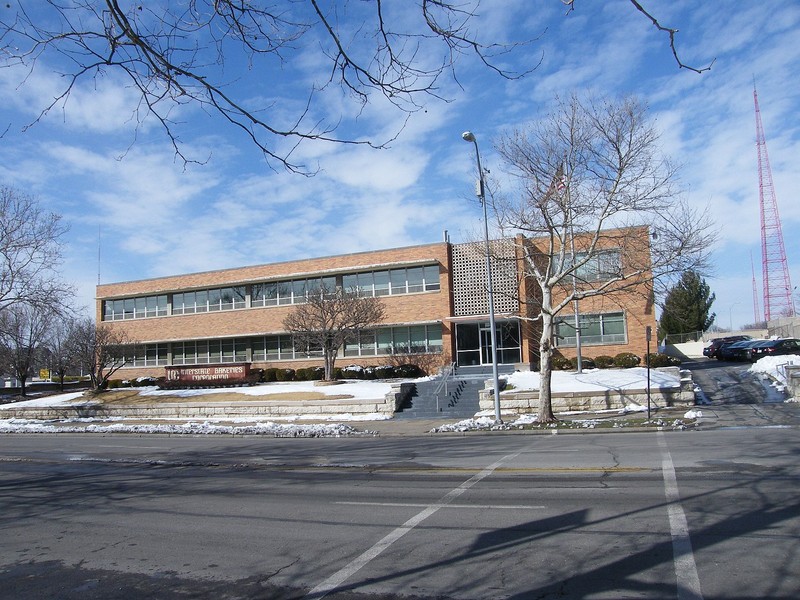Interstate Bakeries Corporation Headquarters (1952-2009)
Introduction
Text-to-speech Audio
Ralph Leroy Nafziger founded Interstate Baking in 1930, although the business ultimately started in 1910 when he started a baking operation in a church basement. Nafziger came from a family of bakers, a common occupation in Kansas City around the turn of the century as the city enjoyed a reputation as a wheat hub. As well, Kansas City had a well-established distribution network (notably railways) due to its central location and manufacturing success. By the 1990s, the company grew into the largest baking company in the U.S. and owned such iconic brands as Hostess and Wonder Bread. The company built its Kansas City headquarters in two stages, in 1952 and 1961. Following two bankruptcies, the company relocated to Texas and its former headquarters building is now home to the Interstate Flats apartments.
Images
Interstate Bakeries Corporation Headquarters

Backstory and Context
Text-to-speech Audio
The Interstate Baking Corporation began as a $30 million corporation in 1930, although its genesis dates back to 1910 when Ralph Leroy "Roy" Nafziger started his first bakery in the basement of a burned-out church. Continued mergers and acquisitions pushed the company to expand and incorporate as The Interstate Baking Corporation, establishing its headquarters in Kansas City. Construction of the rectangular south wing of the Interstate Bakeries Corporation Headquarters finished in 1952, and completion of the L-shaped rear (north) wing occurred in 1961. By the 1990s, Interstate Bakeries Corporation had acquired iconic brands, such as Hostess and Wonder Bread, earned $200 million in sales annually, and was the country's largest baking company. The success story ended with two bankruptcy filings in 2009 and 2012. Still, the Headquarters Building speaks to the company's exceptional twentieth-century success and Kansas City's role as a hub for wheat production and related industries in the early and middle twentieth century.
Ralph Nafziger started his first bakery in 1910, operating out of the basement of a burned-out church after dropping out of architecture school in New York. Nafziger grew his business, acquiring smaller bakeries in New York, Pennsylvania, Tennessee, Texas, Iowa, California, and St. Louis, Missouri. By 1930, Nafziger's holdings had grown substantially, which allowed him to create a $30 million baking business called Interstate Bakeries Corporation (IBC), with its headquarters rooted in Kansas City. By the 1940s, IBC also opened plants in Chicago, Omaha, Grand Rapids, Des Moines, Los Angeles, San Diego, and several in the San Francisco area, to name a few locations.
Kansas City was a natural location for a national wholesale bakery to build its headquarters. Kansas City developed into a wheat hub (home to thirty grain elevators) by 1900. By 1919, Kansas City's flour milling output ranked second in the nation. Consequently, in the first quarter of the twentieth century, Kansas City also grew into a baking hub. During the second quarter of the twentieth century, Kansas City evolved into a wholesale baking epicenter, with 397 union bakers employed at fifty bakeries by 1927. Two primary bakeries operated in Kansas City by 1927: Purity Bakeries Corporation (what would become Interstate Bakeries Corporation) and Empire Baking Corporation. The bakeries benefited from Kansas City's centralized location in the U.S. and its well-established distribution network and manufacturing infrastructure.
By the 1950s, Kansas City gained a reputation as the "mother of bakeries," with five of the six dominant baking companies having traced their origins to Kansas City. But, in 1951, as a result of mergers and takeovers, only IBC still operated its general offices from Kansas City. Like many midcentury Kansas City office buildings, the IBC headquarters and its production facility were in two different locations. The IBC headquarters sat within a desirable Midtown location, while the production facility operated in an industrial area close to rail lines. And by the 1950s, IBC had doubled its annual volume in baked goods since incorporating in 1930. Moreover, IBC acquired Buffalo's O'Rourke bakery for $1 million, which helped IBC establish itself as a truly national brand. The company operated twenty-four bread and cake plants nationwide, producing, among other things, 40 million loaves of bread every day.
IBC's worth grew to $88 million by 1953, one year after construction on its new national corporate headquarters (today's south wing) commenced. The office building housed one hundred employees. From its new headquarters, IBC embarked on an aggressive marketing campaign. For example, in 1954, IBC took out a full-page ad in the Kansas City Star touting their newly-invented "Upside-Down Loaf." In 1961, continued growth pushed IBC to expand its headquarters building, constructing the L-shaped rear (north) wing that effectively doubled the square footage of its office complex. In 1966, with roughly 200 employees in Kansas City (and 10,000 across the nation), IBC earned $200 million in sales; the company stood as the fourth largest baking company in the U.S. by 1968. Broadly expanding again through acquisitions in the 1980s and 1990s, including acquiring Hostess Brands and Wonder Bread (the Indiana-based Taggart Bakeries) in 1995, IBC became the largest wholesale baking company in the country.
But, the twenty-first century proved to be far less successful for IBC. Its immense growth from a church basement in 1910 to the largest baking company ceased in 2004 when IBC filed for bankruptcy. After filing, IBC maintained Kansas City offices but closed several plants throughout the country and later relocated the company's headquarters to Texas and operated as the Hostess Company. In 2012, the company again filed for bankruptcy. Although this building is now home to apartments, the former Interstate Baking Company Headquarters Building survives as a reminder of the company's success, helped in part by Kansas City's position as a wheat and baking hub and the city's well-established distribution network.
Sources
Braude, Michael. "A Century of Agriculture and Its Commerce." Midcontinent Perspectives. Midwest Research Institute. December 1992. https://shsmo.org/sites/default/files/pdfs/kansas-city/mcp/Braude-12-2-92.pdf.
Mumford-Russell, Ellis. "Nomination Form: Interstate Bakeries Corporation Headquarters." National Register of Historic Places. nps.gov. 2015. https://npgallery.nps.gov/GetAsset/42eeafcf-ead4-438d-87f0-06f49a8da846.
By Americasroof - Own work, CC BY-SA 3.0, https://commons.wikimedia.org/w/index.php?curid=6079877
